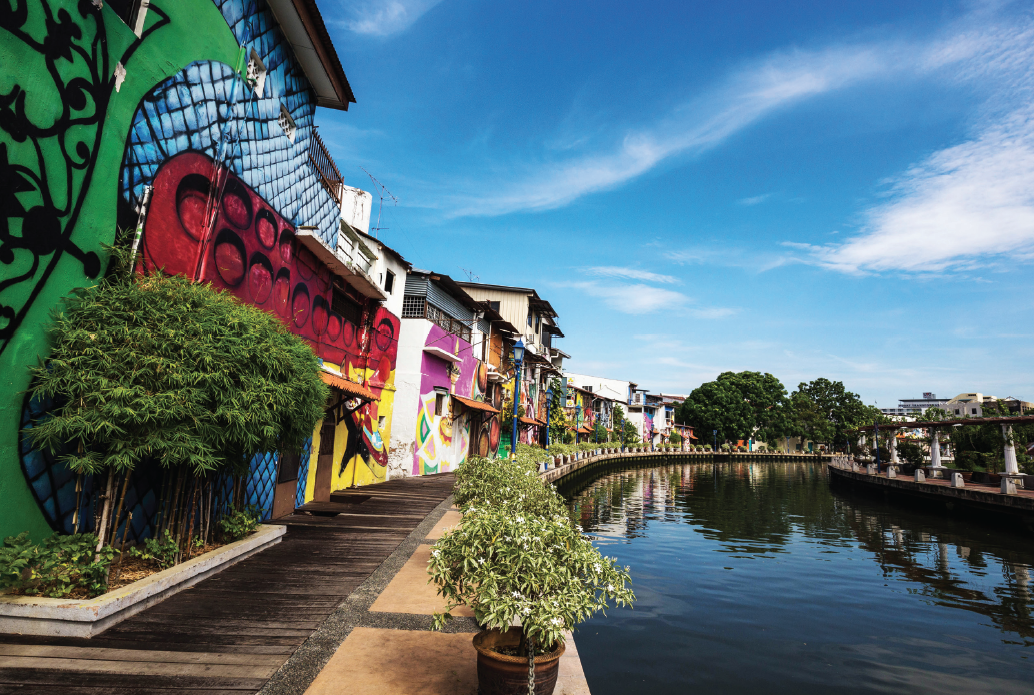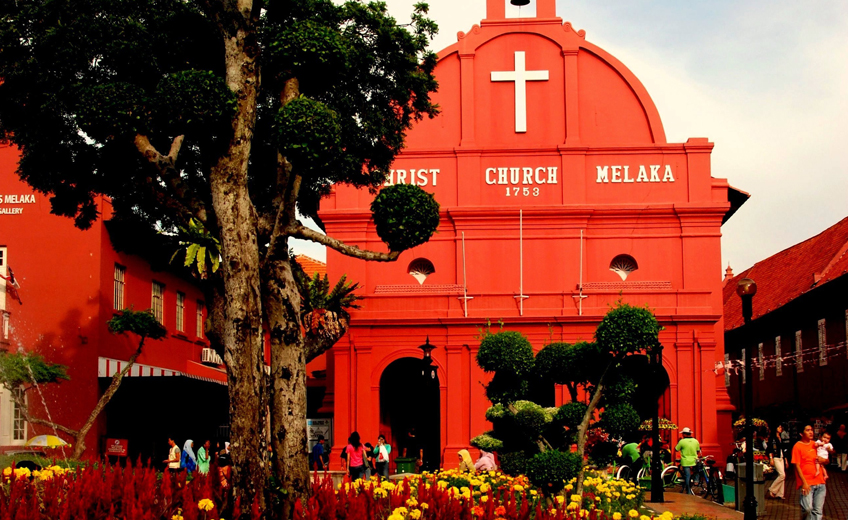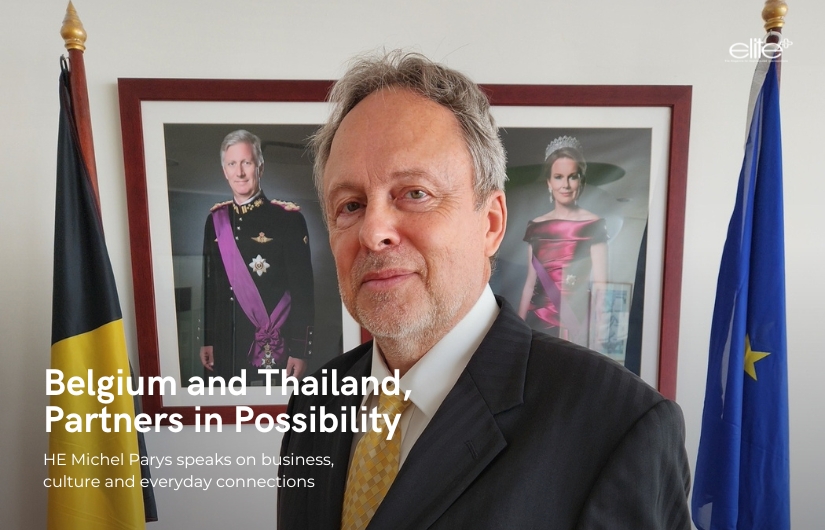History, beautiful architecture, preserved Peranakan culture, traditional lifestyle and art – Malacca has it all. The city enjoyed centuries of prosperity from maritime trade and then the influences of colonialism. Lining its memory lanes are gorgeous Sino-Portuguese buildings and old Chinese shop houses, some offering delicious Nyonya cooking, beaded shoe shops and artsy cafes. The Malacca River is idyllic by day and illuminated by night. Around every corner you can find wall paintings, creative graffiti and traditional practices that are dying out. Around two and a half hours from Kuala Lumpur, this UNESCO World Heritage city is a charming holiday destination or ideal escape from the metropolis.
Malacca, known locally as Melaka, was founded in 1400 by the Hindu king Parameswara, who had escaped from a fallen empire in Sumatra. According to legend, the king, resting under a Malacca tree, saw a mouse deer chase his hunting dog into the water, and so the kingdom received its name. Due to the influence of Arab, Persian and Indian traders, Malacca soon turned into an Islamic sultanate and the king himself converted. The kingdom rose to prominence as trade flourished. Traders of different races – Gujaratis, Tamils, Arabs, Bugis, Chinese – passed through and settled down, establishing their own communities. Interracial marriages took place and created the multi-ethnic society Malacca still is today.
But Malacca’s success didn’t only attract well-wishers. Lured by the state’s wealth, the Portuguese arrived in 1511, the first of several foreign conquests. By the mid-16th century, Aceh and Johor, two nearby sultanates, fought the Portuguese for control over Malacca, turning it into a three-way battlefield. In 1641, the Dutch defeated the Portuguese, and in 1824 the Treaty of London handed the territory from the Dutch to the British. Malacca was also ruled by the Japanese during WWII. In 1963, six years after Malaya’s independence from Britain, Malacca became part of the Federation of Malaysia.
Today beautiful colonial shop houses andb mansions, the pride of rich Chinese merchants and wealthy Peranakan families from a bygone era, dominate the historical city. Administrative buildings built by the Dutch have been turned into museums. The Malays, Chinese, Peranakans (mixed race Chinese-Malays), Indians, Arabians and others live harmoniously on the same streets.

The proximity of the city’s attractions makes it easy to explore Malacca on your own. The area is small but there is much to explore by day or night.
Museum Hopping
Malacca’s historical city has no fewer than 21 museums. For an introduction, start at the History and Ethnography Museum, or Stadthuys, located in the Red Square (9am-6pm, closed on Mondays). This former governor’s residence, built in 1650 by the Dutch, is a sprawling complex that houses an extensive collection of artefacts from the town’s heyday to the colonial era, such as silver crocodileshaped coins and weapons. The culture and way of life of Malacca’s residents are illustrated by models, such as of ancient houses that you can walk through. The second floor tells the history of Malacca from its founding to the establishment of the independent Federation of Malaya. Next to the Stadthuys on the square are the Victoria Water Fountain and the Tan Beng Seng Clock Tower, popular backdrops for signature photos of Malacca.
Next head to the Maritime Museum (9am-5.30pm), a replica of the Flor de la Mar, a Portuguese ship wrecked in the Strait of Malacca five centuries ago, and climb aboard to see exhibits in the inner quarters. It has informative displays about the maritime history of one of the most important port towns of the region, various models of colonial ships, early navigation techniques and even Malaysia’s sea creatures. If a fan of tall and narrow staircases, climb to the upper deck and meet the crew in the captain’s pit.
Another unmissable museum is the Sultanate Palace (9am-5pm), which recreates the lives of the Islamic rulers whose monarchy ended when the Portuguese arrived. The chambers and galleries display photos, weapons, musical instruments, garments worn by different ethnicities in the region, models of seafarers and illustrations of Islamic punishments like stoning to death of couples charged with adultery. If not pressed for time stop by three other noteworthy museums: the Architecture Museum, Stamp Museum and Islamic Museum of Malacca.
Colonial Remnants
Scattered throughout the historic city are remnants of buildings and structures from the Portuguese era. Atop St Paul’s Hill is St Paul’s Church, built in 1521, making it the oldest church in Southeast Asia. Fronted by a statue of St Francis Xavier, the chapel houses several ancient tombstones. On a clear day you can see the sea from the top of the hill, and at the bottom sits the Famosa, the only surviving gate of the Portuguese fortress. It’s a ruin now but very photogenic.
Chinatown and Jonker Street
Made up of four or five streets crossed by numerous alleys, the quarter offers everything you might be looking for – sightseeing, shopping, dining, accommodation and places to hang out. The area is dominated by shop houses and mansions with facades decorated with elaborate high reliefs and stuccos. Some of these have been converted to serve as restaurants, cafes, bakeries, souvenir shops, boutiques and guest houses. It’s easy to mistake someone’s front room for a shop.
The busiest street is Jonker. Commercial as it is, you can still find ramshackle Chinese temples and old-style kopi-tiams sandwiched between shops. The street is famous for Nyonya pastries such as pineapple tarts and lotus biscuits. Ghee Hiang’s is known for its traditional pastries without additives and preservatives.
The real stars of Chinatown, however, are off of Jonker. In side streets and back alleys you can enjoy a more laid-back atmosphere, prettier and artsier coffee shops, and more art galleries. At the corner of Lorong Hang Jebat and Jalan Tukang Emas, it’s hard to miss the yellow and peach mural of the Orangutan House, an art gallery. Jalan Tokong Besi is nicknamed Harmony Street, as it houses Malaysia’s oldest Chinese temple, Cheng Hoon Teng; Kampung Keling Mosque; and Malaysia’s oldest Hindu temple, Sri Payyatha Vinayagar Moorthi. At Jalan Tun Tan Cheng Lock, a quieter street with fewer shops and vehicles, you have more time to photograph the beautiful architecture. Mr Yeo of Wah Aik Shoemaker still makes Chinese bound-feet shoes here, a handicraft of an extinct tradition that his family has continued for three generations.
Not far from Mr Yeo’s, the Straits Chinese Jewellery Museum and Baba Nyonya Heritage Museum (10am-1pm, 2-5pm) are private shop houses owned by descendants of Peranakan families. The Heritage Museum offers a look into the richness and colourful lives of the Peranakans, and walking through the rooms is like stepping into a time warp. Tours led by museum staff last about 45 minutes.

Sights along the River
The Malacca River cuts through the city and boats take you upstream as far as the Taman Rempah Jetty. Enjoy the cool breeze as you pass historic buildings, old warehouses, mangrove stands, churches, villages, murals, bars, restaurants and guest houses where backpackers sit sipping cold drinks. A cruise is good at any time of day but nights are more romantic, with sights illuminated and darkness hiding some of the less appealing details. The cruise takes 45 minutes. Buy tickets and board at Muara Jetty close to the Maritime Museum.
Trip Planner
Get There: Buses leave Kuala Lumpur from Terminal Bersepadu Selatan (TBS) to Malacca around every half hour from 7am to 11pm. There are many bus operators to choose from, including Konsortium Bas Express, Transnasional and Delima.
Stay: Accommodation in Malacca varies from backpacker to boutique and five-star hotel. The Majestic Malacca, Vintage Eleven Villa and Private Malacca Residence are heritage hotels worth considering.
Dine: Chicken rice balls should be on your checklist. There are a few on Jonker Street itself. Among the best are Hoe Kee, Kedai Kopi Chung Wah and Famosa. For local Nyonya cuisine, try Nancy’s Kitchen and order sek bak (braised pork) and sambal sotong petai (sambal squid with bitter beans), or Amy Heritage Nyonya Cuisine for pai tee (crispy deep-fried puff stuffed with vegetables) and chap chai (mixed stir-fry vegetables in bean paste).



















































































































































































































































































































































































































































































































































































































































































































































































































































































































